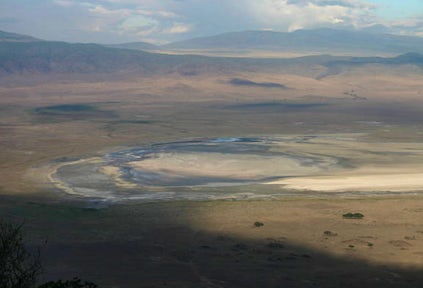The Cradle of Mankind
What draws you to East Africa? Most people say the unparalleled landscapes, the rolling skies, and the endless wildlife that’s incomparable to anywhere else in the world. But as the conversation continues, it always comes down to the people - the passion for their history that has been explored and refined over centuries. It can never be forgotten that a millennia ago, Africa gave birth to mankind.
The origin of our species can be traced to Olduvai Gorge (or Oldupai) in Tanzania, where the world’s oldest undisputed Homosapien fossils were found. Over decades, paleoanthropologists have found hundreds of bones and stone tools here that lead to the conclusion that this is where humans began to evolve.

The gorge feels like stepping onto Mars - red dust shifts and dances over slight mounts that make up the terrain. The only thing that breaks the illusion are the low bushes congregating together in small breaks of green, creeping out from between the cracks. What really catches the eye, however, is the large bloom of rock that sits higher than the rest of the plain. Its jagged petals reach out in all directions, a deeper iron on top leaking into a gradient of paler rust.
Often referred to as Tanzania’s ‘cradle of mankind', it is one of the most important prehistoric sites in the world. It is the very definition of an archaeologists (or Indiana Jones fans) dream.

Located between the Ngorongoro Crater and the Serengeti National Park in the Great Rift Valley, Olduvai Gorge was formed roughly 30,000 years ago. It came about as the result of aggressive geological activity and streams. A river cuts through several layers, forming four independent beds - the oldest of which is estimated to be about 2 million years old.
The dusty ochre gorge spans 48 kilometres and is about 90 metres deep, and stepping forwards to look over it is like stepping back in time to where it all began. German entomologist Professor Kattwinkel was the first to stumble upon the treasure of Olduvai Gorge in 1911, but it was truly founded and explored by Mary and Louis Leakey some 20 years later.

Credit: The Leakey Foundation
Often referred to as ‘the first family of palaeontology’, the lives of the Leakeys and their children mostly revolved around the wonders of Olduvai Gorge. Louis Leakey was a Kenyan-British archaeologist whose work was important in demonstrating that humans evolved in Africa. His wife, Mary Leakey, was a paleoanthropologist who throughout her career, discovered fifteen new species of animal.
Under the shade of a parasol one day in 1959, with thick glasses protected against the sands of the gorge, and a small brush equipped in her white-gloved hand, Mary discovered fossilized parts of a skull from an unidentified hominin. Over the next few weeks, husband and wife painstakingly sifted through dirt and gravel to find 400 jigsaw pieces that made a nearly complete skull.

Other important pieces were to be found during this excavation - tools, evidence of scavenging and hunting found in animal remains - all pointing to the exciting increase of brain capacity that these hominids were evolving, taking the first steps towards what we are today.
In 1972, after the death of her husband, Leakey became director of excavations at Olduvai Gorge. She continued the Leakey family legacy of palaeoanthropology by training her son, Richard, in the field. The site curated at Olduvai Gorge by Mary and Louis is still continued today by their family.
Photo Credit: The Leakey Foundation

Ready to plan your African adventure?
Listen
We'll spend some time listening to your aspirations, then discuss the kind of experience that might suit you.
Match
Next we'll discuss the options, shortlist the best trips for you and present you our impartial recommendations.
Reserve
We'll place a 24 hour hold on your preferred option - without obligation - whilst we talk through the details.
Whatever your budget, group size, length of stay, preferred activity or appetite for adventure, we can help.

